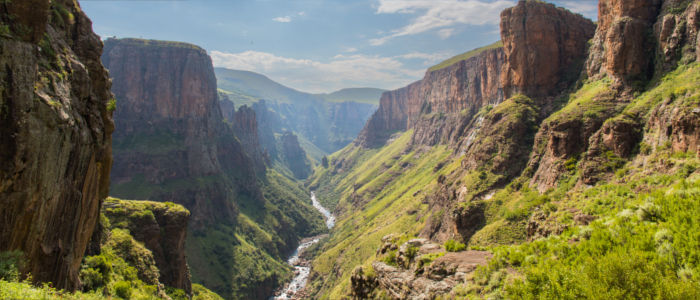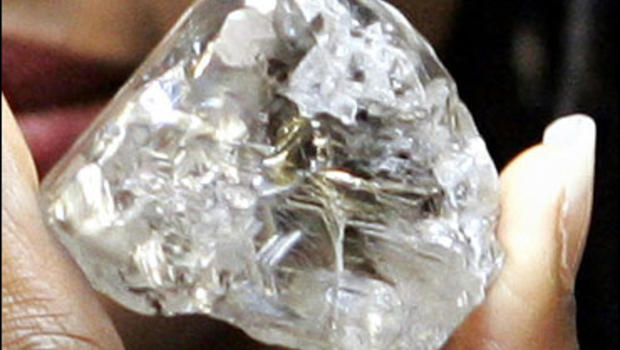The name Lesotho means “the land of the people who
speak Sesotho.” Basotho refers to the people of Lesotho. I saw this kind of
name construction when I covered Botswana (Botswana refers to the land;
Batswana is the people there; Setswana is their language). It makes sense
because the two languages are in the same language group.
Lesotho is a landlocked enclave in the middle of
the country of South Africa. It roughly lies between the South African cities
of Blomfontein and Durban and south of Johannesburg and Pretoria. Lesotho is
only one of four countries that are completely within another country (the
others are Monaco inside France; and San Marino and Vatican City inside Italy).
The country lies in the Drakensburg and Maloti Mountain ranges, making it the
only independent country lying completely above 1400 m (4593 ft). Because of
this, it tends to have cooler temperatures than other areas around it.
The earliest people, the Basotho, came to Lesotho
during the Bantu migration. They ran into troubles, especially with the Zulu
tribes who were also displaced, but there were also many years of peace as
well. Lesotho as we know it came to be in 1822 and was under the guidance of
King Moshoeshoe I (pronounced “muh-shway-shway”). They were still fighting with
the Zulu at this point. At the same time, their country (which was known as
Basutoland during this time) was on edge because of the fighting between the
English and Dutch settlers in South Africa. French missionaries were the first
to transcribe the Sesotho language. As the Boers who settled in South Africa
moved farther inland, there were many disputes as to who owned the land they
were claiming. The British, the Dutch, and the Basotho were pretty much all
against each other (and the British lost a couple of skirmishes and battles to
the Basotho). After several years of fighting with the Boers, King Moshoeshoe I
finally pleaded with Queen Victoria for help, in turn becoming a British protectorate.
After signing a deal with the Boers, Lesotho lost nearly half of its land,
leaving its borders as we know it today. The British also moved the capital
from Thaba Bosiu to Maseru. They continued to have their skirmishes with the
British, but in 1966, the Basutoland gained its independence, and the Kingdom
of Lesotho was born. As the first elections took place, it would be the
beginning of several long decades of shifts of political power and people not
relinquishing the powers they had, and fighting among political parties about
it. There were several times since their independence when they had to deal
with military coups or rioting destroyed part of the city and people died.
The capital city is Maseru, a city on northwestern
border of Lesotho. Although it is Lesotho’s largest city, it only has roughly
228,000 people (about the size of Baton Rouge, Louisiana). The name Maseru
stems from a Sesotho word meaning “red sandstones.” Although many buildings
have been rebuilt and upgraded since the late 1990s, tourism remains to be a
struggling area, mostly likely due to its moderately unstable political scene.
There are only a handful of hotels, and casinos are included in a couple of
them. Setsoto Stadium is a popular place that hosts soccer games (sorry, I mean
football) and other athletic events.
The majority of Lesothans work in agriculture in
some capacity. A significant portion of their economy comes in the form of
remittances from abroad. And although Lesotho has coveted natural resources in
water and diamonds, most of the people who live here live under the global
standard of poverty and the country suffers from a low Human Development Index.
However, some of the world’s largest diamonds have been discovered in Lesothan
mines, and a number of international textile and garment companies have
factories in Lesotho, but it’s not reaching the people. Lesotho has one of the
highest HIV/AIDS rates in the world, and I’m sure this is significantly
affecting their work force.
The vast majority of people in Lesotho practice
some denomination of Christianity, pretty much evenly divided between
Protestant and Catholic. Indigenous religions as well as religions from other
areas (Buddhist, Hindu, Bahá’í, Muslim) are also commonly found throughout
Lesotho.
Sesotho (or sometimes written as Sotho) is the national and official language of
Lesotho, used in business and government. Because of the country’s history with
Britain, English also remains as an official administrative language.
Lesotho is one of the world’s highest countries.
Its altitude has much to do with its culture: one of their cultural clothing
items is a brightly colored blanket. Their conical grass hats (called
mokorotlo) are so iconic, it’s on their flag. The highest pub in Africa is
located in Lesotho. Many travelers who stop there come to see the mountain
views and especially the Sani Pass. Lesotho not only has influences on its
culture from various southern African cultures, but also from British, Dutch
(Boers), and Indian/Asian influences. I’m excited about this meal for one
reason: I get to buy rooibos tea.
Up next: art and literature






No comments:
Post a Comment